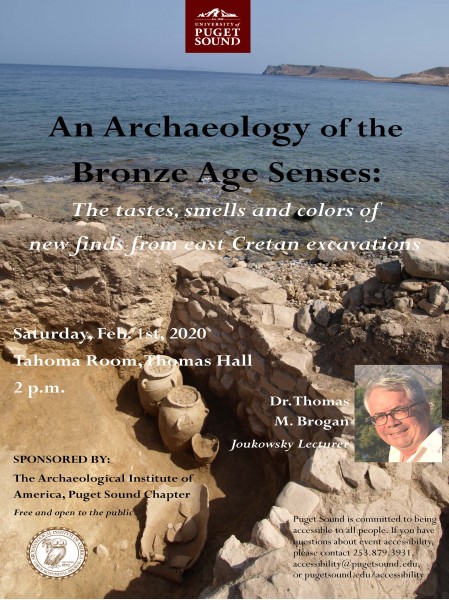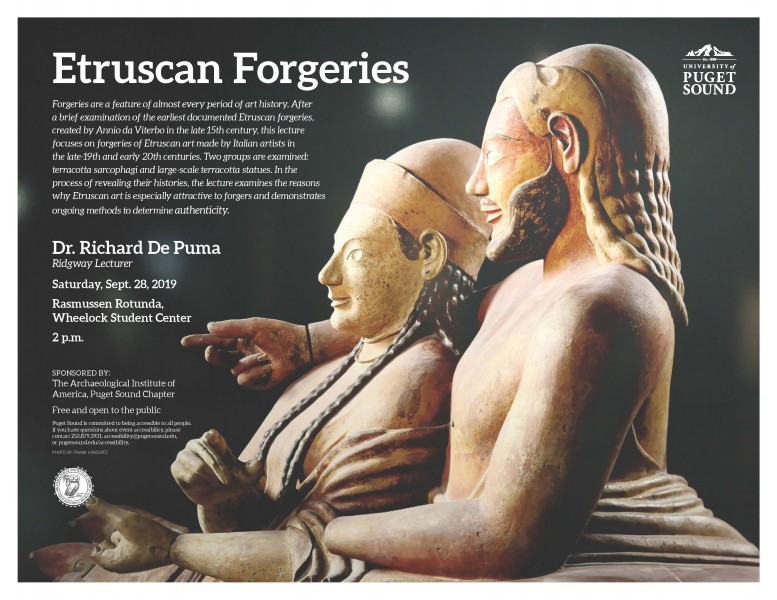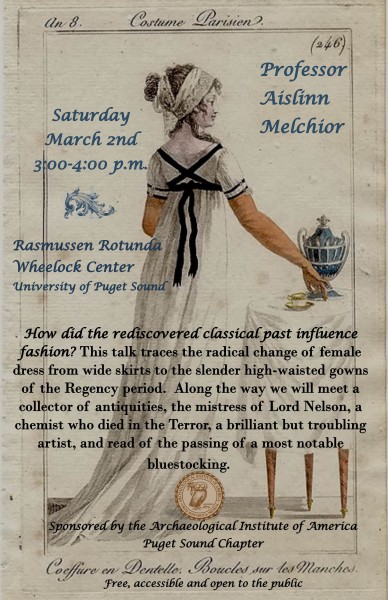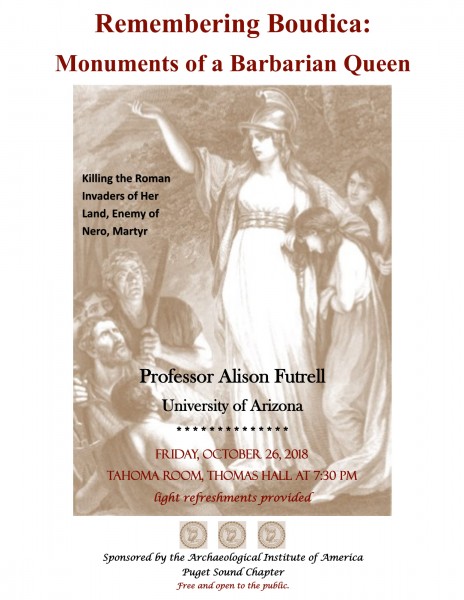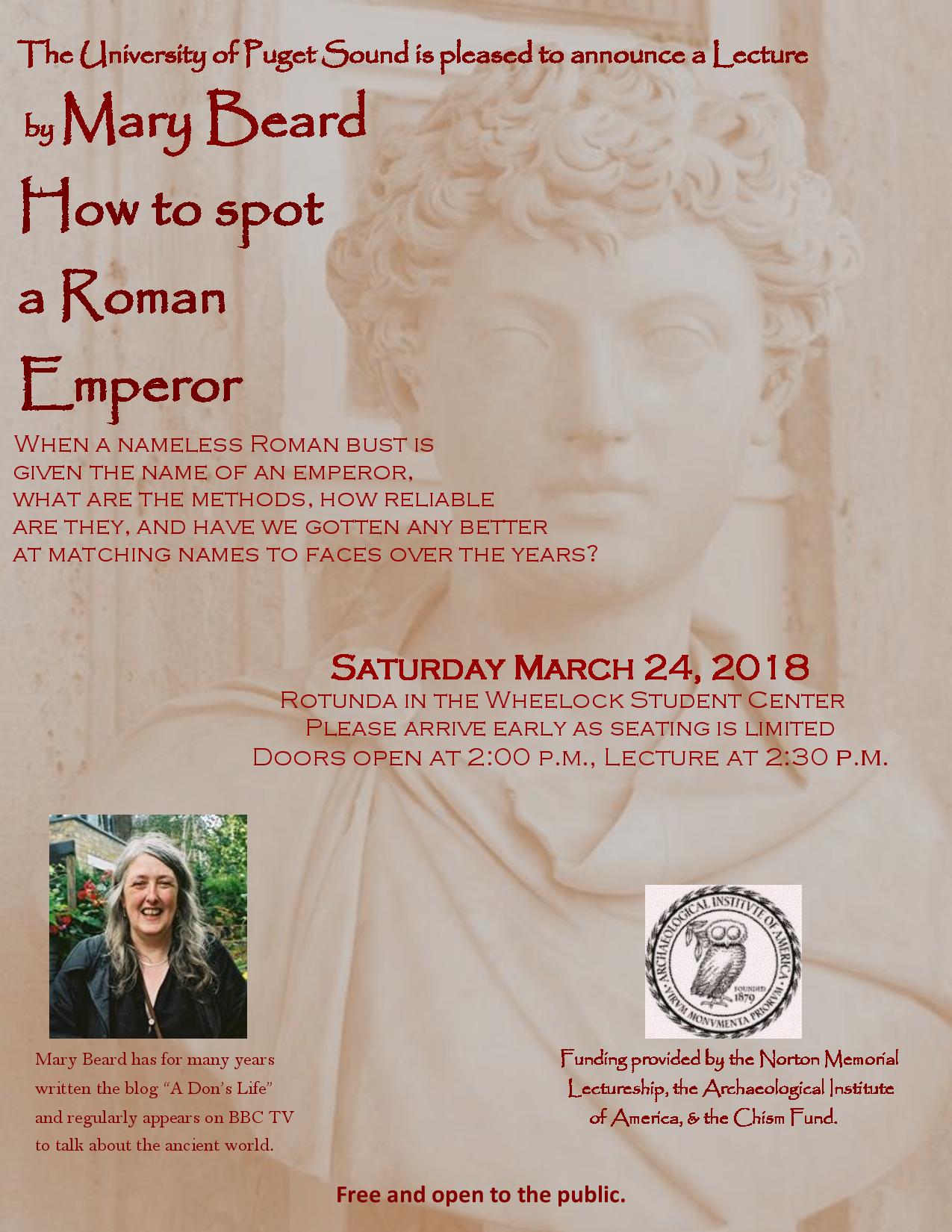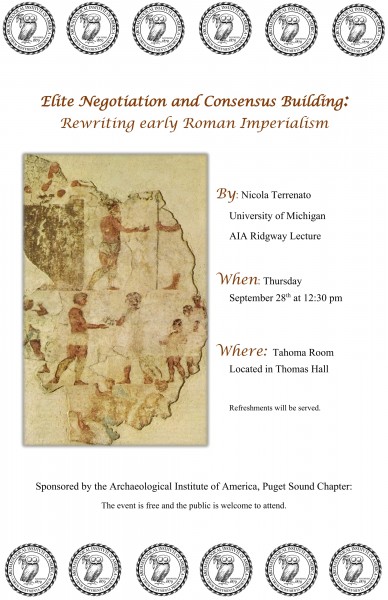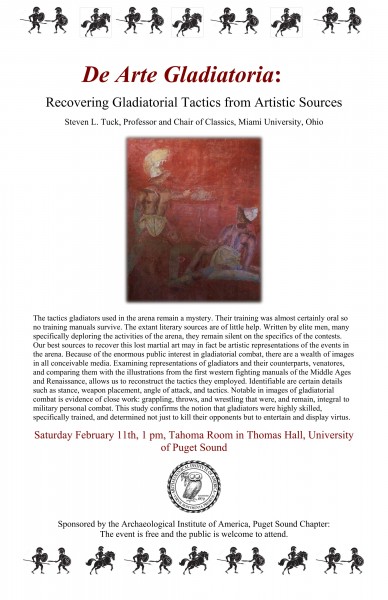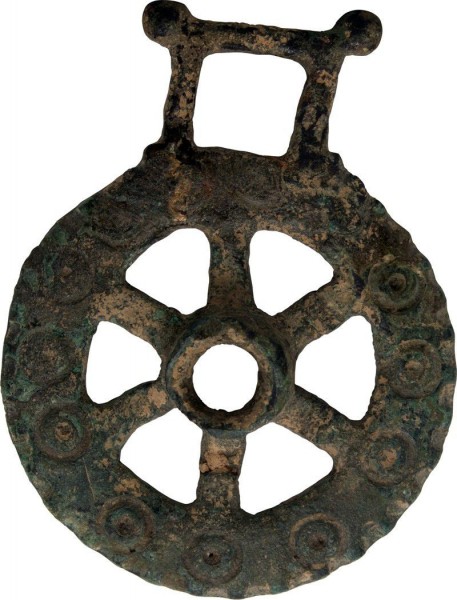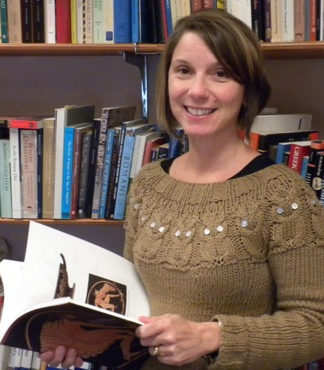For dates and times of all AIA Puget Sound Society lectures – including those held in Seattle on the University of Washington campus, please see: https://sites.google.com/site/seatlaia/
An Archaeology of the Bronze Age Senses:
The tastes, smells and colors of new finds from east Cretan excavations
Dr. Thomas M. Brogan, Joukowsky Lecturer
Saturday, February 1st, 2020
Tahoma Room, Thomas Hall
University of Puget Sound
2: 00 p.m.
Sponsored by:
The Archaeological Institute of America, Puget Sound Chapter
Free and open to the public
Puget Sound is committed to being accessible to all people.
If you have questions about event accessibility, please
contact 253.879.3931, accessibility@pugetsound.edu,
or pugetsound.edu/accessibility.
Etruscan Forgeries
Forgeries are a feature of almost every period of art history. After a brief examination of the earliest documented Etruscan forgeries, created by Annio da Viterbo in the late 15th century, the lecture focuses on forgeries of Etruscan art made by Italian artists in the late 19th and early 20th century. Two groups are examined: terracotta sarcophagi and large-scale terracotta statues. In the process of revealing their histories, the lecture examines the reasons why Etruscan art is especially attractive to forgers and demonstrates ongoing methods to determine authenticity.
Dr. Richard De Puma, Ridgway Lecturer
Saturday, Sept. 28
Rasmussen Rotunda,
Wheelock Student Center
2 p.m.
SPONSORED BY:
The Archaeological Institute of America, Puget Sound Chapter
Free and open to the public
Puget Sound is committed to being accessible to all people.
If you have questions about event accessibility, please
contact 253.879.3931, accessibility@pugetsound.edu,
or pugetsound.edu/accessibility.
PHOTO BY FRANK VINCENTZ
"How Did the Rediscovered Classical Past Influence Fashion?
Aislinn Melchior
Classics professor/Honors Program co-director
University of Puget Sound
Saturday, March 2nd, 2019 at 3:00 p.m.
Rasmussen Rotunda, Wheelock Student Center
University of Puget Sound
This talk traces the radical change of female dress from wide skirts to the slender high-waisted gowns of the Regency period. Along the way we will meet a collector of antiquities, the mistress of Lord Nelson, a chemist who died in the Terror, a brilliant but troubling artist, and read of the passing of a most notable bluestocking.
Sponsored by the Archaeological Institute of America, Puget Sound Chapter
Free and open to the public
Alison Futrell
Joukowsky Lecturer
University of Arizona
Friday, October 26th, 2018 at 7:30 p.m.
Tahoma Room, Thomas Hall
University of Puget Sound
The revolt of Boudica, a tribal queen in the new province of Britannia in A.D. 60, was portrayed by Romans as an example of power gone wrong during the hated Nero's rule. Roman military might was disrupted by Boudica, a barbarian who nevertheless claimed nobility, whose leadership transcended the limits imposed by gender, and a queen who championed liberty. In the post-Roman period, Boudica, was used to construct British national identity; the meaning of Boadica’s body, her sexuality, and her “barbarism” shift with different interpretations of gendered power and of the role played by Rome in Britain’s origins. This talk explores representations of Boudica, from Roman to modern times.
Sponsored by the Archaeological Institute of America, Puget Sound Chapter
Free and open to the public
Mary Beard
Norton Memorial Lecturer
Saturday March 24th, 2018
Rotunda in the Wheelock Student Center
Doors Open at 2:00pm
What did the Roman emperor look like? Among the thousands of surviving Roman imperial marble busts found through the ages, how do we put a name to a face or a face to a name? Every archeologist dreams of finding a bust of Caesar—and some may claim as much. But can we be sure?
Mary Beard, a celebrated University of Cambridge classics scholar known for her BBC television appearances, will present this lecture. She'll discuss the techniques used by scholars to identify nameless busts and whether we have gotten any better at matching names to faces.
Beard, described by The New Yorker as “learned but accessible,” is known for her work on BBC programs such as Meet the Romans and Ultimate Rome: Empire without Limit. She has also worked on shows about daily life in Pompeii and Julius Caesar. Her latest book is New York Times bestseller Women and Power: A Manifesto. She is the classics editor of The Times Literary Supplement and has been described as “Britain’s best known classicist.”
Funding provided by the Norton Memorial Lectureship, the Archaeological Institute of America, and the Chism Fund.
Free and open to the public.
Elite Negotiation and Consensus Building: Rewriting early Roman Imperialism
Nicola Terrenato
University of Michigan
AIA Ridgway Lecture
Thursday, September 28, 2017 at 12:30 p.m.
Tahoma Room, Thomas Hall, University of Puget Sound
Sponsored by the Puget Sound Society of the Archaeological Institute of America.
Professor Terrenato is the Esther B. Van Deman Collegiate Professor of Roman Studies at Michigan, with degrees from the University of Pisa and the Sapienza University of Rome. He is the director of the Gabii Project and the co-director of excavations at San Omobono Project. He is currently completing a book on the role of elite mentality in the formation of cities and empire in the Mediterranean. Dismantling these political abstractions as all-powerful entities, he explores with the help of archaeology the role of specific human groups in political decision-making. His lecture will provide a preview of some of the conclusions in his book and shows how archaeology can inform and deepen historical understanding.
Free and open to the public.
On the Trail of Ancient Greeks and Romans in Plymouth Plantation
Dr. David Lupher, Whitman College
Annual Faculty Lecture
AIA Puget Sound
Saturday, October 8, 2016 at 1p.m.
Tahoma Room, Thomas Hall, University of Puget Sound
Sponsored by the Puget Sound Society of the Archaeological Institute of America.
It is usually assumed that the radical Puritans who settled Plymouth Plantation nearly four hundred years ago were humble in both status and education and were indifferent or even hostile to classical culture. Professor David Lupher will reveal some of the surprises lurking in the probate inventories of the so-called “Pilgrim Fathers,” discussing some of the remarkable books on the shelves of two military men of the settlement: Captains Myles Standish and Thomas Willett. (A teaser: one hitherto unrecognized item was the only novel and the only work by a woman so far detected in Plymouth—a novel based on Herodotus and Xenophon, but also featuring Sappho as a character.) But the “star” of this talk is a volume that David Lupher has examined in Plymouth: Elder William Brewster’s copy of Thomas Lodge’s translation of the prose works of Seneca. His talk will trace the “pilgrimage” of this book from its publication to the present day—including the discovery of the surprising way it came into the hands of the ship captain from whom Brewster bought it. David Lupher will reveal the no less surprising uses that Brewster’s friend Gov. William Bradford made of this book when composing key passages of his history Of Plimmoth Plantation, a classic of early American literature.
Free and open to the public.
De Arte Gladiatoria: Recovering Gladiatorial Tactics from Artistic Sources
Steven L. Tuck, Professor and Chair of Classics, Miami University, Ohio
Annual Faculty Lecture
AIA Puget Sound
Saturday, February 11, 2017 at 1p.m.
Tahoma Room, Thomas Hall, University of Puget Sound
Sponsored by the Puget Sound Society of the Archaeological Institute of America.
The tactics gladiators used in the arena remain a mystery. Their training was almost certainly oral so no training manuals survive. The extant literary sources are of little help. Written by elite men, many specifically deploring the activities of the arena, they remain silent on the specifics of the contests. Our best sources to recover this lost martial art may in fact be artistic representations of the events in the arena. Because of the enormous public interest in gladiatorial combat, there are a wealth of images in all conceivable media. Examining representations of gladiators and their counterparts, venatores, and comparing them with the illustrations from the first western fighting manuals of the Middle Ages and Renaissance, allows us to reconstruct the tactics they employed. Identifiable are certain details such as stance, weapon placement, angle of attack, and tactics. Notable in images of gladiatorial combat is evidence of close work: grappling, throws, and wrestling that were, and remain, integral to military personal combat. This study confirms the notion that gladiators were highly skilled, specifically trained, and determined not just to kill their opponents but to entertain and display virtus.
Free and open to the public.
Warfare in Ancient Persia, 550-330 BC
2015-2016 Ridgway Lecture featuring John W.I. Lee
Associate Professor, Department of History
University of California, Santa Barbara
Thursday, March 10, 2016 at 7p.m.
Room 109, Wyatt Hall, University of Puget Sound
Sponsored by the Puget Sound Society of the Archaeological Institute of America.
Stretching from the Aegean Sea to the Indus valley, the empire of Achaemenid Persia (550-330 BC) was the first global power. To defend their realm, the Great Kings of Persia mustered a diverse array of professional and part-time soldiers, including Iranian cavalrymen, Babylonian archers, and even Greek mercenaries. This lecture explores warfare in ancient Persia using evidence from royal inscriptions, excavated documents, tomb paintings, sculpture, and other sources, with particular attention to the equipment, training, and martial values of the empire’s warriors.
John W.I. Lee is the author of A Greek Army on the March: Soldiers and Survival in Xenophon’s Anabasis published by Cambridge University Press in 2007, and nominated for the Runciman Award, a number of articles on the Greek experience of battle, and a series of lectures on the Persian empire for the Great Lectures/Teaching Company. John is also the faculty liaison to the Student Veterans’ group at UCSB.
Free and open to the public.
Sex and Other Things Sell: Athenian Potters and their Foreign Consumers
Kathleen Lynch, Associate Professor of Classics
University of Cincinnati
AIA Puget Sound Society: Caskey Lecture
Saturday, February 6, 2016 at 1p.m.
Tahoma Room, Commencement Hall, University of Puget Sound
Sponsored by the Puget Sound Society of the Archaeological Institute of America.
This lecture explores how the foreign market for Athenian vases impacted production choices of the Athenian potters. In order to provide a vivid example of the problem, we will first examine erotic images of heterosexual couples on Athenian black-figure and red-figure vases produced from about 525-450 B.C. While these pots are certainly made in Athens, they are found only in Etruria. We will consider why the Athenians marketed these images to the Etruscans, and in turn why the Etruscans may have appreciated them. In order to understand how the export market differed from the domestic pottery market, we will also examine pottery found in genuine Athenian houses. Comparative material will be used to try to understand how the producers of such pots might have been manufacturing an image of exoticism for their foreign customers.
NB: Lecture will contain vase painting images of explicit sexual scenes.
Kathleen Lynch is the author of The Symposium in Context: Pottery from a Late Archaic House near the Athenian Agora that won the AIA Wiseman Book Award in 2013, as well as co-editor on a volume The People of Apulia: New Evidence from Pottery for Workshops, Markets, and Customs. She has also authored a number of chapters and articles from work on the drinking vessels used at symposia to the depositional patterns that occur “when disaster strikes” as exampled by the Athenian agora.


